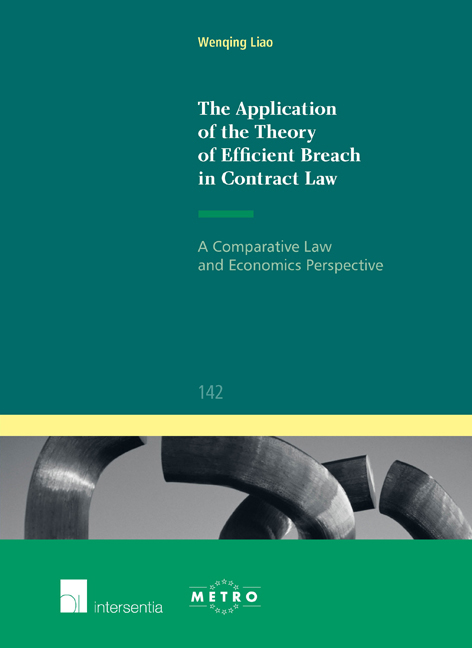 The Application of the Theory of Efficient Breach in Contract Law
The Application of the Theory of Efficient Breach in Contract Law Book contents
- Frontmatter
- Acknowledgements
- Contents
- List of Abbreviations
- List of Tables
- Chapter 1 Introduction
- Chapter 2 Economic Analysis of Contract and Contract Law
- Chapter 3 Efficient Breach in Law and Economics Theory
- Chapter 4 A Re-Examination of the Optimal Rule to Enhance Efficiency
- Chapter 5 Alternative Remedies and Efficient Breach
- Chapter 6 Efficient Breach and European Union Contract Law
- Chapter 7 Efficient Breach and Re-Negotiation in English Sales Law
- Chapter 8 Applying the Efficient Breach Doctrine to Chinese Commercial Sales Law
- Chapter 9 A Comparative Law and Economics Analysis of Efficient Breach in English Law, EU Law and Chinese Law
- Chapter 10 Concluding Remarks and Policy Recommendations
- References
- Table of legislation and European or international instruments
- Cases
- Valorization Addendum
- Ius Commune Europaeum
Chapter 1 - Introduction
Published online by Cambridge University Press: 12 December 2017
- Frontmatter
- Acknowledgements
- Contents
- List of Abbreviations
- List of Tables
- Chapter 1 Introduction
- Chapter 2 Economic Analysis of Contract and Contract Law
- Chapter 3 Efficient Breach in Law and Economics Theory
- Chapter 4 A Re-Examination of the Optimal Rule to Enhance Efficiency
- Chapter 5 Alternative Remedies and Efficient Breach
- Chapter 6 Efficient Breach and European Union Contract Law
- Chapter 7 Efficient Breach and Re-Negotiation in English Sales Law
- Chapter 8 Applying the Efficient Breach Doctrine to Chinese Commercial Sales Law
- Chapter 9 A Comparative Law and Economics Analysis of Efficient Breach in English Law, EU Law and Chinese Law
- Chapter 10 Concluding Remarks and Policy Recommendations
- References
- Table of legislation and European or international instruments
- Cases
- Valorization Addendum
- Ius Commune Europaeum
Summary
Background
Against a background where commercial trading is growing and becoming more complex in modern society, private parties are appealing for more flexibility and freedom in taking commercial decisions, rather than strictly abiding by the documents they have signed. Correspondingly, the traditional study of contract law, which offers a fundamental legal structure for trade, has received more theoretical debate. The traditional legal idea that breach of contract is wrong and should be avoided has been challenged. Law and Economics, with its efficient breach theory, obviously provides one of the strongest voices and provides a utilitarian approach to explain contract and promissory obligations, which have been influenced greatly by the traditional notion of pacta sunt servanda and the moralistic nature of obligations. In 1897, Judge Oliver Wendell Holmes wrote in his well-known book “The Path of the Law’ that: “The duty to keep a contract at common law means a prediction that you must pay damages if you do not keep it, and nothing else.” Afterwards, this illustration of contract became a strong support for the theory of efficient breach, which is assumed to have been clarified first in Birmingham in 1970 and received its name by Goetz & Scott 1977.
Structured on the contract's functions of optimally allocating goods and factors of production as well as enhancing social welfare, the theory of efficient breach is stipulated to count all gains and losses in monetary value in the period between the birth and death of a contract. In the early stage, after the theory was born, it was used mainly to describe a desirable kind of breach, where the promisor's gain from breach, after paying expectation damages, exceeds his profit from performance. This sort of breach was assumed to be a movement toward economic efficiency and consistent with the contract parties’ economic preference. Scholarly efforts were made to justify this theory from an economic perspective. Before that, there was Coase's statement that “once the costs of carrying out market transactions are taken into account it is clear that such a rearrangement of rights will only be undertaken when the increase in the value of production consequent upon the rearrangement is greater than the costs which would be involved in bringing it about.” Birmingham reached a similar conclusion when illustrating the case where an employee gets a better job.
- Type
- Chapter
- Information
- The Application of the Theory of Efficient Breach in Contract LawA Comparative Law and Economics Perspective, pp. 1 - 16Publisher: IntersentiaPrint publication year: 2015
